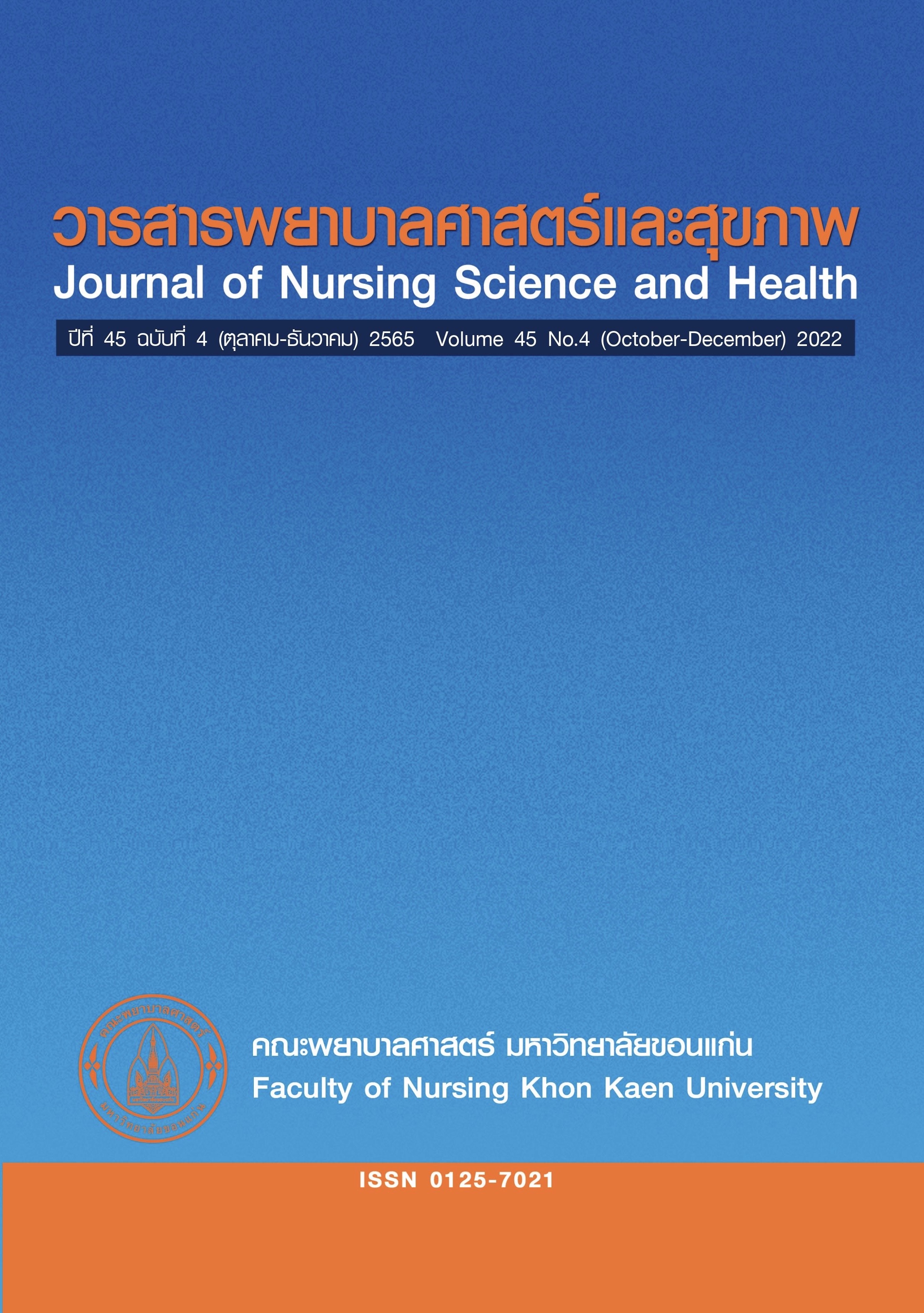ภาวะสุขภาพของวัยรุ่นที่มีภาวะสมองพิการ: ตามการรับรู้ของผู้ดูแล
คำสำคัญ:
ผู้ดูแล, ภาวะสุขภาพ , วัยรุ่นสมองพิการบทคัดย่อ
การวิจัยเชิงพรรณนา เพื่อศึกษาภาวะสุขภาพของวัยรุ่นที่มีภาวะสมองพิการตามการรับรู้ของผู้ดูแล ทำการศึกษาในวัยรุ่นที่มีภาวะสมองพิการที่เข้าศึกษาในโรงเรียนศรีสังวาลย์ขอนแก่น จำนวน 100 คน เครื่องมือที่ใช้ในการเก็บรวมรวมข้อมูลคือ แบบสอบถามข้อมูลทั่วไปของวัยรุ่นที่มีภาวะสมองพิการและผู้ดูแล แบบสอบถามภาวะสุขภาพของวัยรุ่นที่มีภาวะสมองพิการตามการรับรู้ของผู้ดูแล ค่าดัชนีความตรงเชิงเนื้อหาเท่ากับ 1.00 วิเคราะห์ข้อมูลด้วยสถิติการแจกแจงความถี่ ร้อยละ ค่าเฉลี่ย และส่วนเบี่ยงเบนมาตรฐาน
ผลการศึกษาพบว่า ผู้ดูแลมีการรับรู้ภาวะสุขภาพของวัยรุ่นที่มีภาวะสมองพิการทั้ง 5 ด้าน ดังนี้ 1) ด้านร่างกาย วัยรุ่นที่มีภาวะสมองพิการร้อยละ 96 มีปัญหาด้านการเคลื่อนไหวและความคล่องตัวในการทำกิจวัตรประจำวัน ร้อยละ 60 การพูดและการสื่อสาร 2) ด้านจิตใจ วัยรุ่นร้อยละ 29 ที่มีภาวะสมองพิการมีอารมณ์โกรธและหงุดหงิดง่ายร้อยละ 66 มีอารมณ์เครียด ซึมเศร้า เหงา โดดเดี่ยว 3) ด้านสังคม วัยรุ่นที่มีภาวะสมองพิการร้อยละ 50 มีสัมพันธภาพที่ดีกับมารดามากที่สุด และมีปัญหาความสัมพันธ์กับเพื่อนร้อยละ 47 4) ด้านสติปัญญา วัยรุ่นที่มีภาวะสมองพิการร้อยละ 67 มีปัญหาด้านการบวก-ลบเลข ร้อยละ 59 ไม่สามารถแก้ปัญหาที่มีความยุ่งยากซับซ้อนได้ 5) ด้านจิตวิญญาณ วัยรุ่นที่มีภาวะสมองพิการร้อยละ 100 มีความเชื่อและปฏิบัติตัวตามหลักคำสอนของพุทธศาสนา ผู้ดูแลมีจุดมุ่งหมายในการดูแลวัยรุ่นที่มีภาวะสมองพิการให้ถึงที่สุดจนกว่าจะตายจากกันร้อยละ 95
พยาบาลควรส่งเสริมให้ผู้ดูแลมีความสามารถและศักยภาพในการดูแลสุขภาพของวัยรุ่นที่มีภาวะสมองพิการให้ครบทั้ง 5 ด้าน เพื่อตอบสนองตามภาวะสุขภาพของวัยรุ่นที่มีภาวะสมองพิการได้อย่างเหมาะสม
เอกสารอ้างอิง
Sucharitpong S, Rungpraiwan R, Hansakunachai T, Benjasuwanthep B, Feuangfoo A, Juthaphisit J, et al., editors. Textbook of child development and behavior. 4 th ed. Bangkok: Child Development and Behavior Club of Thailand; 2018. (in Thai)
The center for children with special needs seattle children’s hospital. Cerebral palsy critical elements of care. USA: Seattle. Washington: Center for Children with Special Needs; 2011.
Shusterman M. The cerebral palsy tool kit. CP now. South Carolina: Greenville; 2015.
Graham H, Rosenbaum P, Paneth N, Dan B, Lin JP, Damiano DL, et al. Cerebral palsy. Nat Rev Dis Primers 2016;2:15082. Available from: http://doi.org/10.1038/nrdp. 2015.82
National Statistical Office. Survey report of disabilities’ persons 2017. Bangkok: National Statistical Office; 2017. [Retrieved 12 Apr 2020]. Available from: http://www.nso.go.th. (in Thai)
Ngamthanawat P, Chavasiri S. Epidemiology of pediatric patients at department of rehabilitation medicine, Siriraj hospital. J Thai Rehabil Med 2016;26(1):31-8. (in Thai)
Na-Rungsri K. Primary caregivers’ voice: Experience of food preparing and feeding children with cerebral palsy. TMJ 2014;14(4):589-97. (in Thai)
Yamaguchi R, Perry KN, Hines M. Pain anxiety and emotional and behavioral problems in children with cerebral palsy. Disability and Rehabilitation 2014;36(2):125-30. Available from: http://doi.10.3109/09638288.2013.782356
Teeraworrawach W. Relationship between coping patterns and family well-being of caregivers of child with cerebral palsy. J Ment Health Thai 2019;27(3):145-58. (in Thai)
Wintels SC, Smits D-W, van Wesel F, Verheijden J, Ketelaar M. How do adolescents with cerebral palsy participate? Learning from their personal experiences. Health Expect 2018;111. Available from: http://doi.org/10.1111/hex.12796
Sigurdardottir S, Indredavik MS, Eiriksdottir A, Einarsdottir K, Gudmundsson HS, Vik T. Behavioural and emotional symptoms of preschool children with cerebral palsy: A population‐based study. Dev Med Child Neurol 2010;52(11):1056–61. Available from: http: //doi:10.1111/j.1469-8749.2010.03698.x
Hongrapipat J. A comparative study of quality of life (QOL) and mental health of caregiver with cerebral palsy child with healthy control. MJSBH 2014;29(3):139-48. (in Thai)
Marrón EM, RedolarRipoll D, Boixadós M, Nieto R, Guillamón N, Hernández E, et al. Burden on caregivers of children with cerebral palsy: Predictors and related factors. Univ Psychol 2013;12(3):767-77. Available from: http: doi:10.11144/Javeriana.UPSY12-3.bccc
Dieleman LM, Van Vlaenderen R, Prinzie P, De Pauw SW. Parents’ need-related experiences when raising an adolescent with cerebral palsy. Adv Neurodev Disord 2019;3:204–19. Available from: https://doi.org/10.1007/s41252-019-00111-3
Ferreira MC, Garcia NR, Prudente COM,Ribeiro MFM. Quality of life of adolescents with cerebral palsy: Agreement between selfreport and caregiver’s report. Rev. Latino-Am. Enfermagem2020;28:e3300.[Access Aug 20, 2021]. Available from:https://www.scielo.br/j/rlae/ a/fWHmK5GtwkfQ9ycPy6njDGN/?format=pdf&lang=en. doi:http://dx.doi.org/10.1590/15188345.3928.3300.
Bianchi LP, Keiko ST, Roberta C, Thelma SM. Social participation: The perspectives of adolescents with cerebral palsy and their mothers. Int J Dev Disabil 2019;1-10. Available from: http://doi:10.1080/20473869.2019.1623596
World Health Organization. International classification of functioning, disability and health (ICF). Geneva: World Health Organization; 2001.
World Health Organization. Classification of functioning, disability and health. Children and Youth Version 2007. Geneva: World Health Organization;2007.
Rosenbaum PL, Livingston MH, Palisano RJ, Galuppi BE, Russell DJ. Quality of life and health-related quality of life of adolescents with cerebral palsy. Dev Med Child Neurol 2007;49:516–21.
Tantilipikorn P, Watter P, Prasertsukdee S. Identifying assessment measures and interventions reported for Thai children with cerebral palsy using the ICF-CY framework. Disabil Rehabil 2012;34(14):1178-85. Available from: http://doi:10.3109/09638288.2011. 637603.
Power R, King C, Muhit M, Heanoy E, Galea C, Jones C, et al. Health-related quality of life of children and adolescents with cerebral palsy in low- and middle-income countries: A systematic review. Dev Med Child Neurol 2018;60(5):469-79. Available from: http://doi:10.1111/dmcn.13681.
Tan SS, van Meeteren J, Ketelaar M, Schuengel C, Reinders-Messelink HA, Raat H, et al. Long-term trajectories of healthrelated quality of life in individuals with cerebral palsy: A multicenter longitudinal study. Arch Phys Med Rehabil 2014;95(11):2029-39. Available from: http://doi:10.1016/j.apmr.2014.04.031.
Malila P, Seeda K, Machom S, Salangsing N, Eungpinithpong W. Effects of Thai massage on spasticity in young people with cerebral palsy. J Med Assoc Thai 2015;98 Suppl 5:S92-6.
Srisangwan School, Khon Kaen. Annual report of the educational institution (SAR), academic year; 2018 [Internet]. Khon Kaen: Srisangwan School, Khon Kaen; 2018. [cited 2020 Mar 28th]. Available from: http://www. srisangwankhonkaen.ac.th/swkk/th/node/ 145. (in Thai)
Boonchana S. Preliminary research methodology in health. Documents for training workshops in developing routine work into research for public health personnel, Public Health Office. Khon Kaen; 2017. (in Thai)
Srisathitnarakun B. Development and quality inspection of research instruments: Properties: Psychological measurements. Bangkok: Chulalongkorn University; 2012. (in Thai)
Wannasuntad S, Kanchanaaree S. Intervention for training and empowering caregivers of cerebral palsy children: A scoping review. J Health Nurs Res 2019;35(3):235-49. (in Thai)
Colver A, Thyen U, Arnaud C, Beckung E, Fauconnier J, Marcelli M, et al. Association between participation in life situations of Children with cerebral palsy and their physical, social, and attitudinal environment: A cross-sectional multicenter European study. Arch Phys Med Rehabil 2012;93:2154-64.
Majnemer A, Shikako-Thomas K, Lach L, Shevell M, Law M, Schmitz N. Mastery motivation in adolescents with cerebral palsy. Res Dev Disabil 2013;34(10):3384-92.
Panyatanakun N, Terathongkum S, Sakulhongsopon S. Factors associated with caregiving behavior of family caregivers of children with cerebral palsy in Bangkok. TJNMP 2019;6(1):5-18. (in Thai)
Makris T, Dorstyn D, Crettenden A. Quality of life in children and adolescents with cerebral palsy: A systematic review with meta-analysis. Disabil Rehabil 2019;1-10. Available from: http://doi:10.1080/09638288.2019.1623852
Duangdech W, Patoomwan A, Pookboonmee R, Orathai P, Roberta S. Rehm. A causal model of health status of children with cerebral palsy. Pacific Rim Int J Nurs Res 2017;21(4):291-304.
ดาวน์โหลด
เผยแพร่แล้ว
รูปแบบการอ้างอิง
ฉบับ
ประเภทบทความ
สัญญาอนุญาต
ลิขสิทธิ์ (c) 2022 วารสารพยาบาลศาสตร์และสุขภาพ

อนุญาตภายใต้เงื่อนไข Creative Commons Attribution-NonCommercial-NoDerivatives 4.0 International License.
วารสารพยาบาลศาสตร์และสุขภาพเป็นเจ้าของลิขสิทธิ์ในการเผยแพร่ผลงานที่ตีพิมพ์ห้ามผู้ใดนำบทความที่ได้รับการตีพิมพ์ในวารสารพยาบาลศาสตร์และสุขภาพไปเผยแพร่ในลักษณะต่าง ๆ ดังนี้ การนำบทความไปเผยแพร่ออนไลน์ การถ่ายเอกสารบทความเพื่อกิจกรรมที่ไม่ใช่การเรียนการสอน การส่งบทความไปตีพิมพ์เผยแพร่ที่อื่น ยกเว้นเสียแต่ได้รับอนุญาตจากวารสารพยาบาลศาสตร์และสุขภาพ



